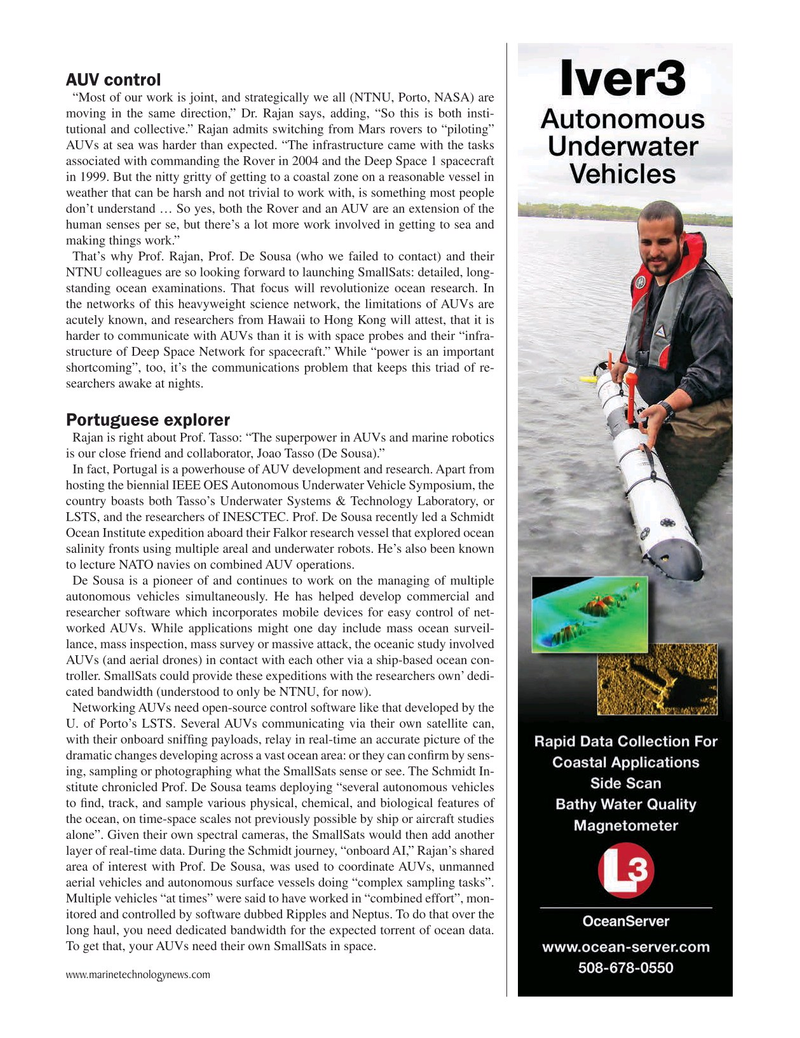
Page 57: of Marine Technology Magazine (March 2019)
Oceanographic Instrumentation: Measurement, Process & Analysis
Read this page in Pdf, Flash or Html5 edition of March 2019 Marine Technology Magazine
AUV control “Most of our work is joint, and strategically we all (NTNU, Porto, NASA) are moving in the same direction,” Dr. Rajan says, adding, “So this is both insti- tutional and collective.” Rajan admits switching from Mars rovers to “piloting”
AUVs at sea was harder than expected. “The infrastructure came with the tasks associated with commanding the Rover in 2004 and the Deep Space 1 spacecraft in 1999. But the nitty gritty of getting to a coastal zone on a reasonable vessel in weather that can be harsh and not trivial to work with, is something most people don’t understand … So yes, both the Rover and an AUV are an extension of the human senses per se, but there’s a lot more work involved in getting to sea and making things work.”
That’s why Prof. Rajan, Prof. De Sousa (who we failed to contact) and their
NTNU colleagues are so looking forward to launching SmallSats: detailed, long- standing ocean examinations. That focus will revolutionize ocean research. In the networks of this heavyweight science network, the limitations of AUVs are acutely known, and researchers from Hawaii to Hong Kong will attest, that it is harder to communicate with AUVs than it is with space probes and their “infra- structure of Deep Space Network for spacecraft.” While “power is an important shortcoming”, too, it’s the communications problem that keeps this triad of re- searchers awake at nights.
Portuguese explorer
Rajan is right about Prof. Tasso: “The superpower in AUVs and marine robotics is our close friend and collaborator, Joao Tasso (De Sousa).”
In fact, Portugal is a powerhouse of AUV development and research. Apart from hosting the biennial IEEE OES Autonomous Underwater Vehicle Symposium, the country boasts both Tasso’s Underwater Systems & Technology Laboratory, or
LSTS, and the researchers of INESCTEC. Prof. De Sousa recently led a Schmidt
Ocean Institute expedition aboard their Falkor research vessel that explored ocean salinity fronts using multiple areal and underwater robots. He’s also been known to lecture NATO navies on combined AUV operations.
De Sousa is a pioneer of and continues to work on the managing of multiple autonomous vehicles simultaneously. He has helped develop commercial and researcher software which incorporates mobile devices for easy control of net- worked AUVs. While applications might one day include mass ocean surveil- lance, mass inspection, mass survey or massive attack, the oceanic study involved
AUVs (and aerial drones) in contact with each other via a ship-based ocean con- troller. SmallSats could provide these expeditions with the researchers own’ dedi- cated bandwidth (understood to only be NTNU, for now).
Networking AUVs need open-source control software like that developed by the
U. of Porto’s LSTS. Several AUVs communicating via their own satellite can, with their onboard snif? ng payloads, relay in real-time an accurate picture of the dramatic changes developing across a vast ocean area: or they can con? rm by sens- ing, sampling or photographing what the SmallSats sense or see. The Schmidt In- stitute chronicled Prof. De Sousa teams deploying “several autonomous vehicles to ? nd, track, and sample various physical, chemical, and biological features of the ocean, on time-space scales not previously possible by ship or aircraft studies alone”. Given their own spectral cameras, the SmallSats would then add another layer of real-time data. During the Schmidt journey, “onboard AI,” Rajan’s shared area of interest with Prof. De Sousa, was used to coordinate AUVs, unmanned aerial vehicles and autonomous surface vessels doing “complex sampling tasks”.
Multiple vehicles “at times” were said to have worked in “combined effort”, mon- itored and controlled by software dubbed Ripples and Neptus. To do that over the long haul, you need dedicated bandwidth for the expected torrent of ocean data.
To get that, your AUVs need their own SmallSats in space. www.marinetechnologynews.com
MTR #2 (50-65).indd 57 3/11/2019 12:23:39 PM

 56
56

 58
58
